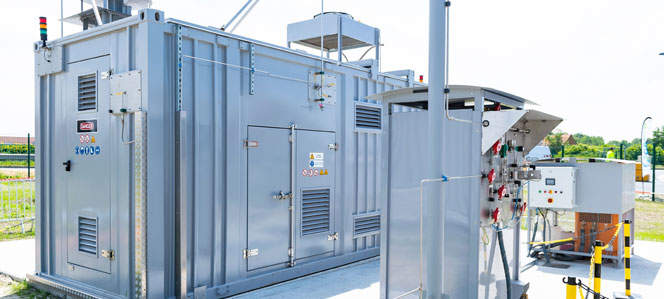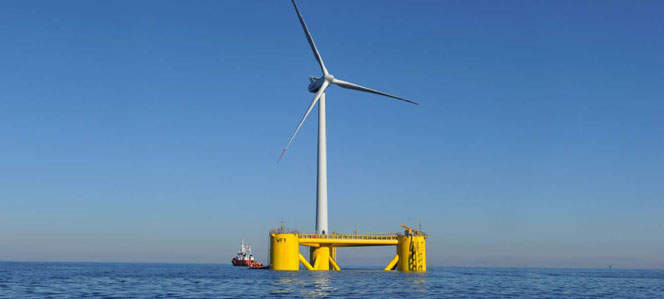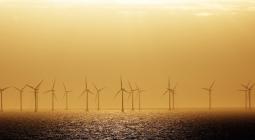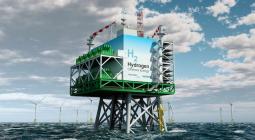Engie's renewables chief on scaling corporate contracts, hydrogen hopes and offshore wind.

Earlier this year, French-born energy company Engie made a bold proclamation — it will add at least 9 gigawatts of renewable energy between now and 2021, at least half of which will come from power purchase agreements (PPAs) signed by companies or public-sector entities including cities, universities and hospitals.
For context, according to a recent report, Engie had 24.4 GW renewable capacity at the end of 2018, split among solar (2 GW), wind (5.5 GW) and hydro (16 GW). (It has small but growing businesses in biomass and geothermal.)
Over the past three years, it has reduced the amount of power it generates from coal-fired power plants by 75 percent — through sales and closures. Just 4 percent of its remaining capacity is attributable to coal and it has slightly more than that in nuclear power. A substantial portion of its revenue is attributable to power generated by natural gas.
Many new renewable contracts Engie intends to sign will include clauses for making sure renewables are available 24/7, which means they'll be hybrid arrangements that include a mix of clean (or cleaner) power sources such as solar, wind and hydro and, increasingly, some sort of storage — Engie has big aspirations in green hydrogen.
And, increasingly, the deals will look a lot like the innovative, groundbreaking arrangement Engie forged with Microsoft and announced in September. The whopping 230-megawatt contract includes both solar and wind from two Texas-based facilities that are due to become operational in January 2021. What makes it unique is a firming arrangement that ensures Microsoft's local operation is actually covered by renewables on a 24-hour basis.
"Having something where you can look at renewables close to the point of consumption with new capacity and mixing different profiles of production of renewables, I think that's the future," said Gwénaëlle Avice-Huet, executive vice president in charge of the global renewables and green hydrogen business line for Engie, and president and CEO of the Engie North America operation.
I recently spoke with Avice-Huet in-depth about the company's evolving renewables strategy, its recipe for innovation and why the power company is investing in emerging technologies to make natural gas greener. Following is an excerpt of our conversation, edited for clarity and length.
Heather Clancy: Clearly a lot of technology companies have been very active in the PPA movement, because of their big data centers. Are there other industries that are especially active or interested?
Gwénaëlle Avice-Huet: Obviously you’re right, we’ve been working with numbers of companies for the data centers, but we’ve also delivered some corporate PPAs for big companies like Walmart or Target. It is because they want to decarbonize their electricity consumption. But we see also some middle-size companies, smaller companies that want to have part of the consumption from a PPA, for example.
Clancy: Is that an intended focus moving forward? In other words, developing products for midsize and small companies.
Avice-Huet: Yeah, that’s exactly that. We obviously see large companies joining, but we also see smaller companies wanting to have access to these new wind and solar projects, and so that’s why it is an opportunity to develop a PPA and to share the PPA between different companies, and sometimes to have smaller companies taking part in a PPA. We see a trend where the request to have green energy is not coming from larger corporates but also from smaller ones.
But that’s very good, because the movement is happening at every level, different size of organization. It’s really a movement that is spreading across the whole industry, and that’s very positive, and we see that because there is more request from the citizens and the young generation to have access to solutions.
Clancy: The public sector interest is another area where you’re building your business. In that segment, there’s municipalities, hospitals or universities. Where are you seeing the most demand?
Avice-Huet: We see a large demand coming from what we call the MUSH sector: municipalities; universities; schools; and hospitals. Basically, they want to be part of this solution, not be part of the problem. And they want to have someone taking care of all the different components to decarbonize their footprint to be more attractive in terms of having more students to join one university [versus another], for example. Because for the young generation, sustainability matters, and so it’s a way to attract students.
In Ohio, we’ve entered into a partnership with Ohio State University. It’s a 50-year partnership, and our target is to reduce their energy consumption by 25 percent in 10 years within a $250 million budget.
Our discussion with the university was, "Well, to optimize your carbon footprint, we can work on energy consumption. If you consume less energy, then you have less in carbon impact." The second element is to produce very efficient solutions and to produce green energy. And the last point is to produce innovative solutions…

So as part of this 50-year partnership, what we committed is to have economic collaboration. We have a $150 million [commitment] over 50 years, including internships, scholarships and faculty — and around energy and sustainability. We will also build a new energy innovation center within the university … We will invest more than $1.1 billion on the concession, and at least three times this amount during the 50 years of the concession to modernize, to replace installations and to propose, all the time, the best technology that exists.
When you start a discussion like that, it’s really a partnership over time where you can always innovate. You can create a sustainable environment, and we see that happening at Ohio State, but we also see that in many other universities…
I see that also happening with hospitals. In Boston, we are operating a district heating and cooling network, and it’s providing heating and cooling for a group of highly respected hospitals in Boston. For hospitals, what matters for them is reliability.
Clancy: What role will emerging technologies such as hydrogen, biogas and energy storage play in these arrangements?
Avice-Huet: We see a real future for gas, and when we say that, that means gas will turn to be green. To do that, there are two different areas [we’re investing in]. The first one is biomethane, and the second one is green hydrogen.
On biomethane, there [are] some developments in California, especially, and worldwide in many other geographies, especially in Europe. The technology is already available. It’s not a long-term technology. It’s available today. We need to industrialize it to make sure we can reduce the cost. It’s still more expensive than traditional natural gas, but it’s just a starting point, and we see that coming up with good industrialization in a very short timeframe. So for me, biomethane is a way to green gas, and it’s a short-term solution.
Green hydrogen, it’s a way to produce hydrogen based on renewable assets. What you can do is that you have assets that sometimes produce energy not at a time of consumption. Let’s take a wind farm that can produce at some point where there is no consumption: It’s not easy to store electricity. You’ve got batteries, but [that technology is] not deployed everywhere. Hydrogen is a way to store energy from this intermittency, meaning that we can have a wind farm and we can do an electrolysis of the water, extract green hydrogen and store the hydrogen.
So, we’re working on that. It’s an emerging technology. We see the implementation based on industrial consumption. There are many industries across the world that are consuming hydrogen for their processes. For example, to produce ammonia. They need to have green hydrogen to de-carbonize the footprint. It’s the case of the chemical industry, of the mining industry, and others.
Clancy: Historically speaking, your renewable business includes a very substantial portion of hydro capacity. What role do you see hydro playing in the future?
Avice-Huet: In 2018, we had 24.4 gigawatts of installed capacity including 16.4 GW from hydro. The hydro parts, the hydro components are coming from Brazil and from France. There is not much development across the world now. The big dynamics are on wind and solar and offshore and other new technologies, like geothermal and environment, et cetera.
But we see there are some developments, we see hydro as a good complement to other technologies … When a client will request to have 100 percent renewable solutions available any time, having a renewable path that is coming from hydro and that is dispatchable when it’s necessary — it’s a good solution to combine it with other intermittent renewables. So that’s why we see it as a good complement. That’s why in our in our portfolio.
In France, we propose collaboration between wind and solar and hydro because we really think that hybrid solutions combining different profiles of production is a good way to have something reliable for clients, and that is 100 percent green. So that’s why hydro for us is still a big component of our renewable footprint. We truly believe in the contribution of hydro for corporate PPAs, city PPAs and, yes, for 24/7 solutions.
Clancy: What is your vision for offshore wind, especially in the United States?
Avice-Huet: We have already projects ongoing. The most major ones are in Europe. We have two projects under development in France. We have one project in construction in the U.K. and another one in Belgium, and we did all the projects together with EDP Renewables (EDPR). What [we] announced a few months ago is that we are creating a JV, a joint venture with EDPR to put together our pipelines of development in terms of offshore to be big. We want to be big in this market. It is a very dynamic market.
Today, we have 1.5 GW worldwide in construction. And we have 4 GW in advanced development. Our objective for 2025 is to have between 5 and 7 GW under construction or operational, and to have 5-10 GW under advanced development.

And so to do that, we have three areas of focus. We have the U.S., Europe and Asia...
[In the U.S.], we see two areas of interest. The first one is the East Coast, in places like New Jersey and Connecticut. We also see potential in the West Coast, EDPR has been developing one innovative floating project for 100 megawatts in California…
In Europe, we are constructing — we are building right now the first floating offshore pilot in Portugal, and the next one will be in France.
Clancy: What will it take for there to be more corporate PPAs for offshore wind projects? I know there aren’t many. What needs to happen for that to be more practical?
Avice-Huet: It is starting in Europe. There are some: there were projects attributed without any subsidy, and so the objective is really to commercialize electricity for clients. So, we see a trend. It was not possible in the past because the cost of the offshore technology was much too expensive. Remember, it was like $200 per megawatt-hour five years ago, so it was so much expensive, nobody could have done a corporate PPA.
The first thing was the decrease of the cost of technologies, and it has improved so fast. Now it’s becoming much more relevant, and the second element is that in the U.S., we’ve had the solar Investment Tax Credit (ITC) and the wind Production Tax Credit (PTC), but we don’t have anything special for offshore having some support in terms of fiscal incentive … And the second element is the support, the political support, the incentives to make sure it deploys.
Clancy: You went there, so I’m going to stay there for a second. The political support: Does the market change for you when the incentives expire federally in the United States?
Avice-Huet: Are you talking just about offshore wind or also onshore and solar?
Clancy: I’m talking about everything. So that’s a general question.
Avice-Huet: Well, first, we believe that a carbon price would be necessary at some point, and as soon as possible, to make sure that it incentivizes the new technologies. We truly believe this would be the best option. Now how long it will take, that is the question. I think it is our responsibility to say that this is something that we would advocate for on the long-term. So, this is the first element.
Now the second element: we would want the energy transition to happen, and to happen in a way that is affordable. I mean, having technologies that are competitive is really a necessity to make sure it deploys and that it is attractive enough for citizens, for corporate [buyers], etc. So having affordable renewable is something that is really important.
When it comes to the ITC and the PTC, the ITC is much more progressive. What we say is that we should focus the support on the new technologies first ….
For solar and wind, if there is an extension, that would be positive for the industry. However, if there is no extension, I don’t see wind and solar stopping here in the U.S. Why is that? Because there are still requests from corporate and from the citizens who progressively have more and more sustainable solutions.
Clancy: Is there anything else you’d like to leave me with? Any other final message you’d like to convey that I haven’t asked you about?
Avice-Huet: We did a very big transformation. We were a very big company, like 160,000 employees across the world doing lots of thermal generation, and four years ago, Isabelle Kocher, our CEO, she said, "I want to be the leader of the energy transition, zero-carbon transition across the world," and we have changed the way we are doing business.
At that point, it was extremely brave, because we had to sell [$16.75 billion] of assets and reinvest in new activities. That was incredible, and we did that in just three years. Here in North America, this is what happened: We were doing coal; we were doing gas production; liquid natural gas; lots of activities. We sold everything, and we’ve acquired companies offering wind, solar and cloud solutions.
At the end of the day, our company, it’s a new one — a new one, fully dedicated to sustainability commitments, and we did that in just three years … I think that’s something that is really noticeable and I’m very proud to be a part of it.
4 November 2019
GreenBiz



